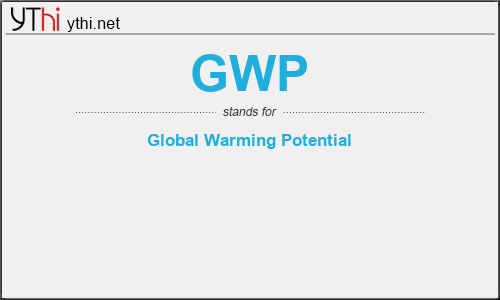What does GWP mean? What is the full form of GWP?
The Full Form of GWP is Global Warming Potential.
Greenhouse gases (GHGs) warm the Earth by absorbing energy and slowing the rate at which the energy escapes to space; they act like a blanket insulating the Earth. Different GHGs can have different effects on the Earth’s warming. Two key ways in which these gases differ from each other are their ability to absorb energy (their “radiative efficiency”), and how long they stay in the atmosphere (also known as their “lifetime”).
The Global Warming Potential (GWP) was developed to allow comparisons of the global warming impacts of different gases. Specifically, it is a measure of how much energy the emissions of 1 ton of a gas will absorb over a given period of time, relative to the emissions of 1 ton of carbon dioxide (CO2). The larger the GWP, the more that a given gas warms the Earth compared to CO2 over that time period. The time period usually used for GWPs is 100 years. GWPs provide a common unit of measure, which allows analysts to add up emissions estimates of different gases (e.g., to compile a national GHG inventory), and allows policymakers to compare emissions reduction opportunities across sectors and gases.
- CO2, by definition, has a GWP of 1 regardless of the time period used, because it is the gas being used as the reference. CO2 remains in the climate system for a very long time: CO2 emissions cause increases in atmospheric concentrations of CO2 that will last thousands of years.
- Methane (CH4) is estimated to have a GWP of 28–36 over 100 years (Learn why EPA’s U.S. Inventory of Greenhouse Gas Emissions and Sinks uses a different value.). CH4 emitted today lasts about a decade on average, which is much less time than CO2. But CH4 also absorbs much more energy than CO2. The net effect of the shorter lifetime and higher energy absorption is reflected in the GWP. The CH4 GWP also accounts for some indirect effects, such as the fact that CH4 is a precursor to ozone, and ozone is itself a GHG.
- Nitrous Oxide (N2O) has a GWP 265–298 times that of CO2 for a 100-year timescale. N2O emitted today remains in the atmosphere for more than 100 years, on average.
- Chlorofluorocarbons (CFCs), hydrofluorocarbons (HFCs), hydrochlorofluorocarbons (HCFCs), perfluorocarbons (PFCs), and sulfur hexafluoride (SF6) are sometimes called high-GWP gases because, for a given amount of mass, they trap substantially more heat than CO2. (The GWPs for these gases can be in the thousands or tens of thousands.)
GWP
means
Global Warming Potential![]()
Translate Global Warming Potential to other language.


Leave a Reply
You must be logged in to post a comment.